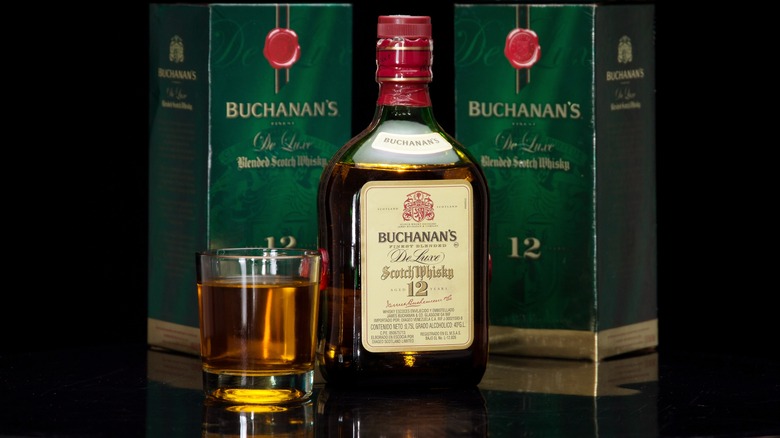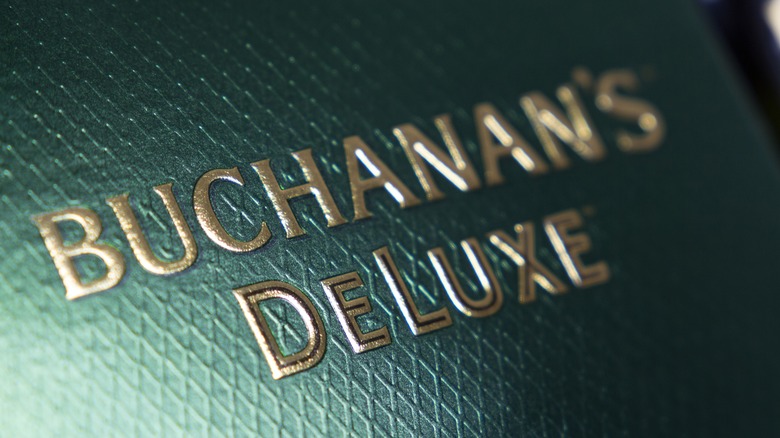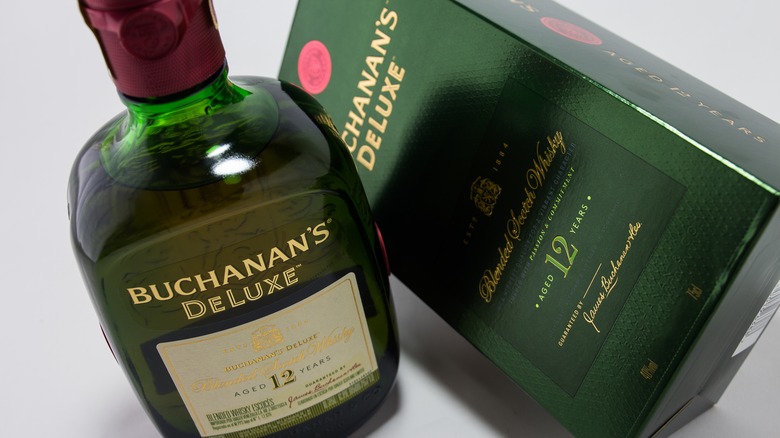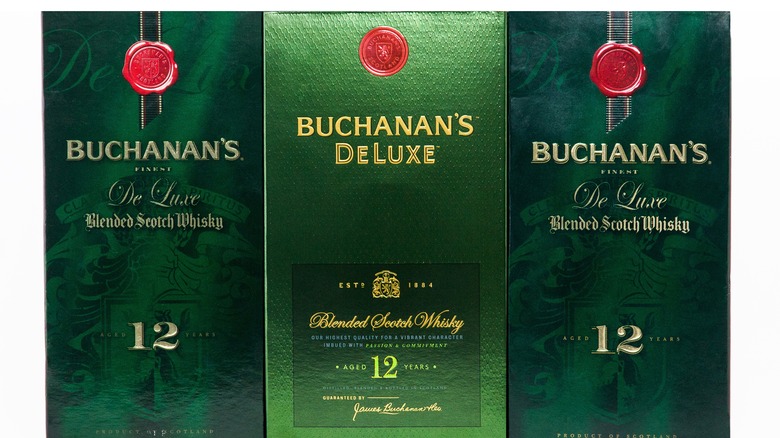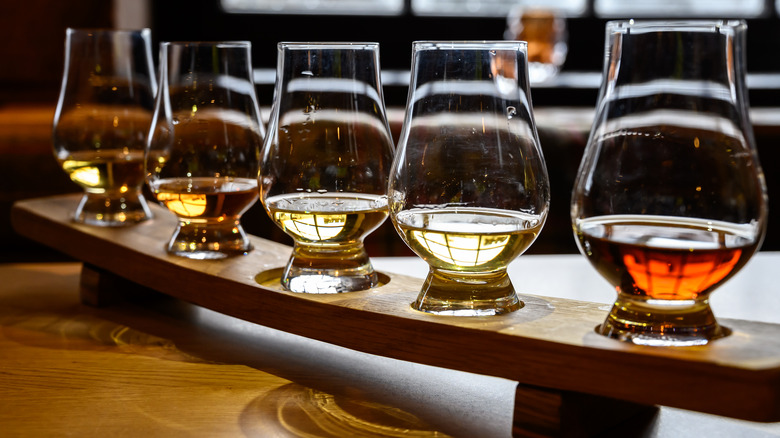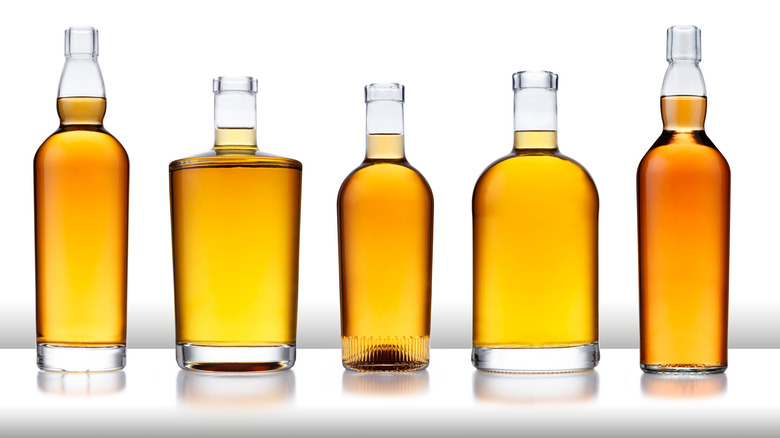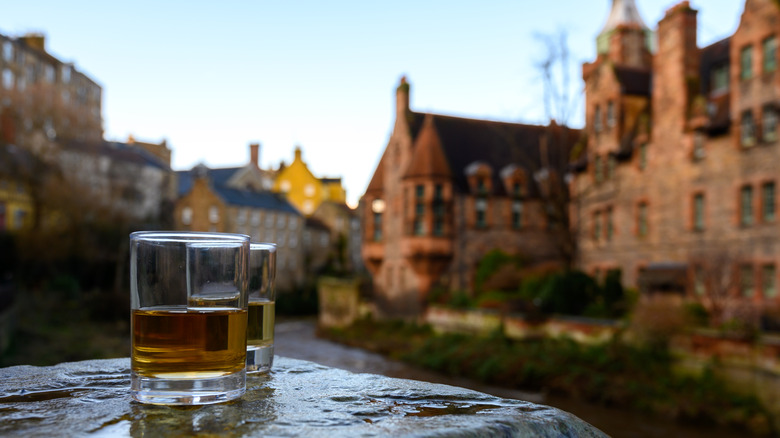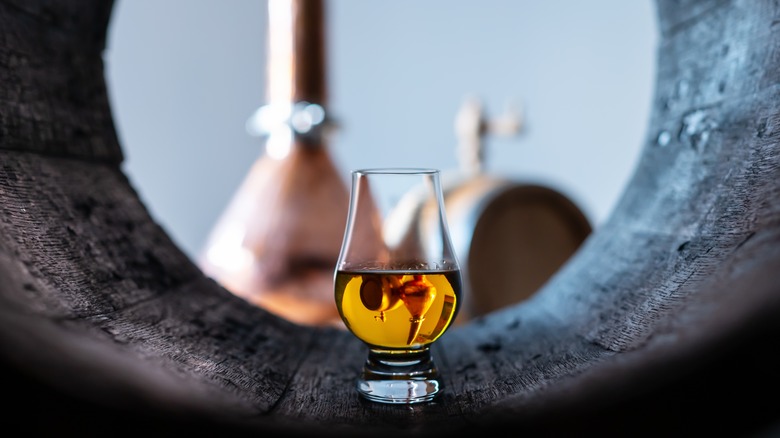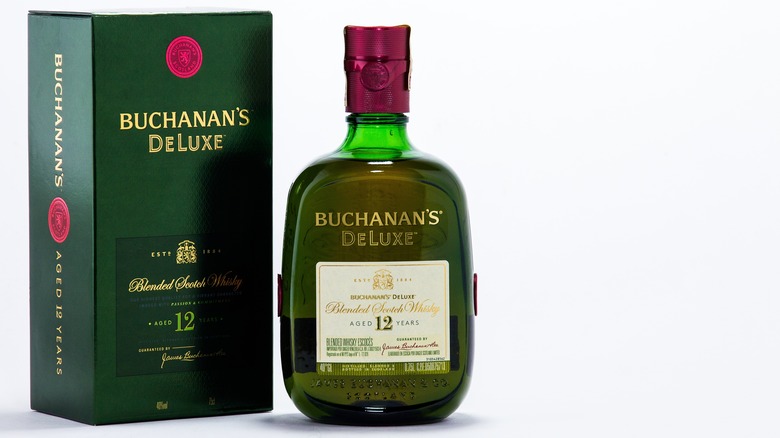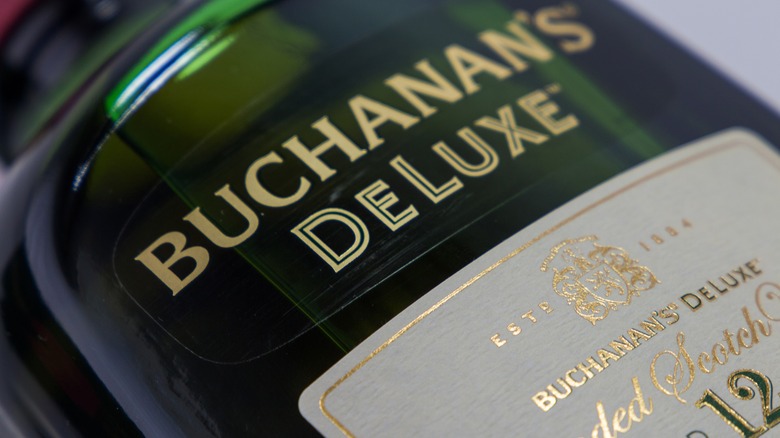Buchanan's 12 Year Scotch: Everything You Need To Know
What started out as Buchanan's Finest Liqueur has evolved over nearly a century to become Buchanan's 12 Year Scotch whisky (via Buchanan's Whisky). Originally intended to be enjoyed by everyone, this whisky boasts smooth, fruity flavors with chocolate notes. It's friendly to those who are averse to drinking any type of Scotch whisky neat, as it can also be drunk on the rocks (with ice) or with mixers like soda. Its creators have played a significant role in advancing the Scotch whisky industry, too, creating a whisky that's won several awards in the process. Among these are a Double Gold Medal and Best in Class Blended Scotch up to 15 Years at the 2020 San Francisco World Spirits Competition, as well as a 96-point rating at the Ultimate Spirits Challenge in 2019 (via Ralphs).
It's no wonder that this is one of the most celebrated whisky brands, as namesake distiller James Buchanan personally assessed and approved the 12 Year Scotch blend, giving it a signature softness. While some may scoff at its low-to-mid price range, as Liquor.com notes, it's an exceptionally versatile drink that will satisfy both cocktail mixers and seasoned sippers. Read on to find everything you need to know about this iconic bottle of scotch.
The story of Buchanan whisky
Officially introduced onto the whisky market in 1884 by James Buchanan, Buchanan's has grown into a renowned brand worldwide. According to ScotchWhisky.com, the first whisky Buchanan produced was the Buchanan Blend, which went on to win Gold at the Paris Centennial Exhibition in 1889. The whisky grew so popular among members of Parliament that it was soon referred to as "that House of Commons whisky." Other creations include the House of Commons (renamed Black & White in 1902), Royal Household, Buchanan's 15 Year Special Liqueur, and Buchanann's 25 Year Rare Old Liqueur.
Per Buchanan's, the first Buchanan's 12 Year Scotch bottle was crafted as an ode to British soldiers' water canteens, which they shared during war times. Unlike many whiskey brands that center a particular audience or market exclusively, this smooth scotch was intended to be enjoyed by everyone, regardless of status. When it was first launched, the bottle was adorned with a Red Lion crest with the phrase "Buchanan's Scotland." However, this has in no way limited its popularity to the region of Scotland alone. It's also enjoyed immense popularity in Bogota, Los Angeles, and Mexico City.
The bottle is inspired by WWI soldiers' canteens
How often have you gone to the store with an idea of what you'd like to purchase, only to be deterred by that cool new product with the interesting package? We've all found ourselves sucked into random purchases all because it appeals to our visual fancy, whether it's a bar of soap, a treat, or a broom. Per Distillery Trail, this is no different when it comes to spirits. That's because, before consumers will ever get a taste of what a distillery has to offer, it's the bottle that inevitably makes a first impression. With Buchanan's, that's intended to get you thinking of the old canteens once used by British soldiers during World War I, where soldiers selflessly shared their precious water with each other in the midst of war (via Buchanan's).
In 2015, that Buchanan's bottle underwent a makeover, as the Design Business Association reports. Instead of chaging the 12 Year Scotch bottle's shape entirely, this served as an opportunity to more subtly update the classic canteen shape. James Buchanan's signature and stamp remain, but a new cap that quite literally breaks the seal was added to mark the occasion of each opening. The family crest, formerly located on the back of the bottle, is now visible from the front.
The brand has a special appreciation for Latin American consumers
In 2016, Buchanan's broadcast a commercial in Spanish during the seventh game of the World Series. At the time, 30% of the players in Major League Baseball were of Latin American heritage, while Chicago was simultaneously not only home of then World Series championship winners, but of the largest Latino population in the US. The Buchanan's commercial in question explicitly and exclusively marketed itself to Latin American consumers, thus making a statement about its place in mainstream society (via Quartz). In one of its more recent commercials, "Buchanan's: What Glory We Are," the brand celebrates being 100% Hispanic, 100% American and living a glorious 200% life.
This comes as part of Buchanan's Whisky's partnership with Kids of Immigrants, a brand collective founded by Daniel Buezo and Weleh Dennis that aims to dig into what it means to be a first generation American (via Forbes). What Glory We Are, a capsule collection, is a product of this partnership. Given that Latin American consumers have remained some of the greatest patrons of Buchanan's Whisky, it's no wonder that the connection has done quite well.
How scotch is different from bourbon and other whiskeys
There are quite a few differences when it comes to whiskies. First: the spelling. According to Insider, it's generally spelled "whiskey" when the spirit in question is made in America, while the liquor distilled in Scotland is spelled "whisky." When it comes to what you are actually consuming from the bottle though, the details boil down to four main factors, as per Healthline. Those are: the grain, location, aging period, and proof of the final product.
Bourbon is made using grain mash, of which at least 51% must be corn (via Healthline). The primary grain used to make scotch is malted barley. In addition to the 51% corn mash bill, bourbon can only be called "bourbon" if it's made in the United States. Meanwhile, scotch can only be made in Scotland. While there are no hard restrictions on how long bourbon must be aged, scotch must be aged for a minimum of 3 years. Both must be at least 80 proof, meaning that they must contain a minimum 40% alcohol content after everything's been distilled and bottled. These four factors are helping in identifying some of the many other types of whisky, too.
The difference between single malt and blended scotch
According to Whisky Advocate, many of us may be surprised to find that the sometimes contentious single malt versus blended debate really just comes down to marketing. Single malt whisky is often assumed to be a "purer" version of whisky and thus assumed to be of higher quality and more expensive. If you've grown accustomed to this assumption, you may be even more surprised to find that single malt are also blends! It turns out that what qualifies whisky as either a single malt or a blend boils down to – and you may need to hold on to your barrels for this – the number of distilleries that were involved in its making (via Great Drams).
According to Great Drams, single malt whiskies are made using a blend of whiskies made from a single malted grain, at a single distillery. Single grain whiskies are a blend of grains such as corn, barley and wheat, with the final product made at one distillery. Meanwhile, blended whiskies are comprised of various whiskies made using malted barley and grain, from a number of different distilleries. Blended malt whiskies contains various malt whiskies — no grain whiskies are invited to this party — which are also made at a variety of distilleries. With this knowledge in your back pocket, feel no pressure to veer toward one over the other. Now that you know what sets them apart, you can get to experimenting and finding your perfect malted match.
Why scotch must be made in Scotland
According to the Scotch Whisky Association, the earliest documented story of distilled Scotch whisky dates back to 1494. As the spirit gained popularity, the Scottish Parliament grew more and more interested in how it could profit from this rising industry. Cue the 1644 introduction of Scotch taxes. For the next 150 years, the number of illegally distilled and smuggled Scotch whiskies continued to increase until the Duke of Gordon proposed the legalization of whisky in Scotland so it could be profitable for everyone.
By the 19th century, James Buchanan and a legion of other distillers had started introducing scotch to other parts of the world. Centuries later, scotch remains one of the most celebrated premier spirits across the globe. It survived Prohibition in the United States, even gaining in popularity as whisky was sometimes passed through as a medical exemption (via Scotch Whisky Association). Today, the production of genuine Scottish scotch is legally safeguarded by the Scotch Whisky Act of 1988 and the Scotch Whisky Regulations of 2009. So strict are these regulations that factors such as whether it's a single or blended malt must be marked on every bottle of Scotch whisky (via The Scotch Advocate).
Why aging scotch increases its value
According to Wine & Liquor, it's not until the spirit has spent years in oak barrels that the Scotch magic happens. What begins as a clear spirit must spend at least three years in these barrels to develop flavor. Yes, it really does taste better with age. Harsher flavors are given time to smooth out, while the unique flavor profiles often hailed by seasoned whisky buffs are brought to the fore (via Black Tail NYC).
In aging, the oak barrel and the whisky are engaged in an intimate dance comprised of several processes, as per Wine & Liquor. Firstly, the wood contains three compounds that flavor the whisky: lignin for those vanilla undertones, lactones that lend a buttery taste, and tannins for balancing out the spice. The second involves the charred insides of the barrel filtering and thus purifying the whisky. The third involves phenol bonding. Given time, the aromatic compounds known as phenols attach themselves to other compounds in the whisky. The more this happens, the smoother the whisky will be.
Scotch whiskies that have been aged for longer may increase in value because they have been given more time to undergo all of these processes. However, don't think that's the only factor to consider. While you may commonly see bottles older than 12 years (with price tags to match), your enjoyment of the scotch inside still comes down to individual palate and preference.
Buchanan's 12 Year Scotch's flavor profile
When it comes to speaking about the flavor profile of a good whisky, three components always take precedence: nose, palate, and finish. As the name suggests, nose refers to the scents that rise out of your tumbler. Palate references the flavors that come to the fore as you swirl it about your mouth. Finish is all about undertones that linger on your tongue after your sip is over. You can also, of course, take your cues from the descriptions provided by distillers and fellow Scotch whisky imbibers.
Per Buchanan's, the 12 Year Old Scotch has a distinctly soft, fruity flavor, with hints of orange and chocolate. According to Master of Malt, Buchanan's 12 Year Scotch's nose boasts hints of peat, orange zest and vanilla cream. The vanilla cream remains on the palate, with a caramel flavored sweetness and an array of orchard fruit flavors to round things out. Its finish hints at the sort of tobacco you may smell wafting from a box of cigars, as well as smoky peat. Of course, the palates of reviewers can be just as idiosyncratic as anyone else, so you may notice different flavors. For instance, ABC Fine Wine & Spirits noted lemon and mandarin orange flavors in the bottle, with hints of bitter dark chocolate.
How to enjoy Buchanan's 12 Year Scotch
If you've ever wondered how exactly Scotch whisky should be best enjoyed, you'll find few people as well-versed in the artistry of this drink than a Scottish bartender. This is exactly who VinePair approached for more about the four distinct ways to enjoy your dram: neat, with water, with ice, in a cocktail. If you're keen to enjoy your Buchanan's 12 Year Scotch neat, a whisky snifter is your best bet. The tulip shape holds onto the whisky's aromas while you're sipping away. For those interested in taking in every layer of flavor in Buchanan' 12 Year Scotch, serving it with water is the way to go, as the addition may "open up" the whisky and allow you taste it all.
If you've only just started honing an interest in whiskies, having it with ice cube will cool and calm any strong flavors and scents which may otherwise intimidate your palate. Make sure the cubes are clean and large — the increased volume will slow melting. If you're cocktail lover, stay strong. The next time someone tries to shame for wasting your whisky by drinking it in a cocktail, you can tell them that in Edinburgh, incorporating Scotch into cocktail is a significant part of the whisky culture. Buchanan's Whisky suggests having the 12 Year Scotch with some soda and topping it with orange peel.
